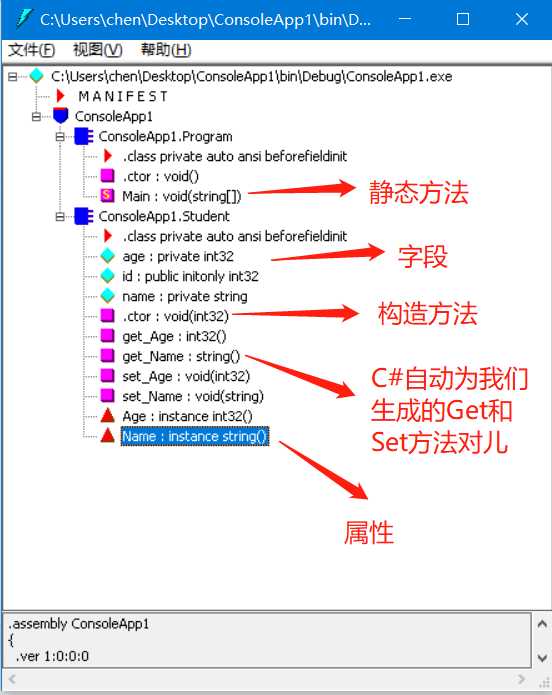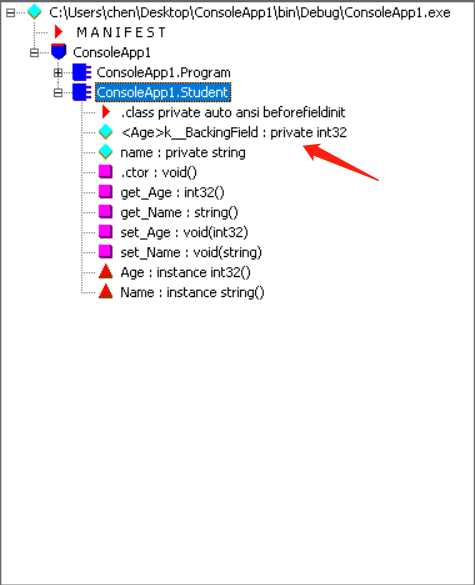class Program
{
static void Main(string[] args)
{
Student student1 = new Student(1);
student1.name = "xiaoming";
student1.age = 519;
Console.WriteLine(student1.name + " " + student1.age);
Student student2 = new Student(2);
student2.name = "mike";
student2.age = -22;
Console.WriteLine(student2.name + " " + student2.age);
Console.ReadKey();
}
}
class Student
{
public readonly int id;
public string name;
public int age;
public Student(int id)
{
this.id = id;
}
}
上述在只有字段的程序中,人的年龄在为负数 或者 八百岁显然是不符合实际的。这就是字段被非法数据污染的一种情况
为了解决这个问题,可以将字段设置成私有字段 然后提供公开的Get和Set方法来设置和获取字段的值
private int age;
//注意使用大驼峰命名 Get后面通常是字段的名字
public int GetAge()
{
return age;
}
public void SetAge(int value)
{
if (value>=0&&age<=120)
{
this.age = value;
}
else
{
throw new Exception($"{value}不在合法范围内");
}
}
//下面是在Main方法中的调用
Student student1 = new Student(1);
student1.SetName("xiaoming");
student1.SetAge(519);
Console.WriteLine(student1.GetName() + " " + student1.GetAge());
运行结果:

上面的Get和Set方法在保护字段上,十分有效Java、C++语言现在仍然在广泛地使用;C#语言的研发团队发现这种写法稍稍有些冗长,于是便发明了"属性"的概念,让开发者以属性的访问来间接达到访问字段的效果
class Program
{
static void Main(string[] args)
{
Student student1 = new Student(1);
student1.Name= "xiaoming";
student1.Age = 19;
Console.WriteLine(student1.Name + " " + student1.Age);
Student student2 = new Student(2);
student2.Name= "mike";
student2.Age= 22;
Console.WriteLine(student2.Name + " " + student2.Age);
Console.ReadKey();
}
}
class Student
{
public readonly int id;
private string name;
public string Name
{
get
{
return name;
}
set
{
// value在setter包装其中是一个上下文 关键字
// value 代表给字段设置值时传入的值
this.name = value;
}
}
private int age;
public int Age
{
get
{
return age;
}
set
{
if (value >= 0 && value <= 120)
{
this.age = value;
}
else
{
throw new Exception($"{value}不在合法范围内");
}
}
}
public Student(int id)
{
this.id = id;
}
}
像使用字段那样使用属性 相较 Get和Set方法对儿 大大减少了程序的冗余







class Program
{
static void Main(string[] args)
{
var student = new Student() { Age = 19, Name = "baobo" };
Console.WriteLine(student.CanWork);
Console.ReadKey();
}
}
class Student
{
private string name;
public string Name
{
get { return name; }
set { name = value; }
}
private int age;
public int Age
{
get { return age; }
set
{
age = value;
}
}
public bool CanWork
{
get
{
if (age >= 18)
{
return true;
}
else
{
return false;
}
}
}
}
输出结果为:True;上述示例中CanWork属性并未显示封装一个字段,当从外界访问这个属性的时候,所得到的值是实时动态计算出来的
程序还可以改写成主动地计算值,如下
class Program
{
static void Main(string[] args)
{
var student = new Student() { Age = 19, Name = "baobo" };
Console.WriteLine(student.CanWork);
Console.ReadKey();
}
}
class Student
{
private string name;
public string Name
{
get { return name; }
set { name = value; }
}
private int age;
public int Age
{
get { return age; }
set
{
age = value;
// 每当age被赋值的时候 主动去计算 canwork字段的值
if (age>=18)
{
this.canWork = true;
}
else
{
this.canWork = false;
}
}
}
private bool canWork;
public bool CanWork
{
get { return canWork; }
}
}
总之,属性是比字段要灵活很多的一种函数成员。建议在能使用属性的地方尽可能多地使用属性。以上便是对属性的总结,记录下来以便以后查阅。
原文:https://www.cnblogs.com/bigbosscyb/p/13702411.html